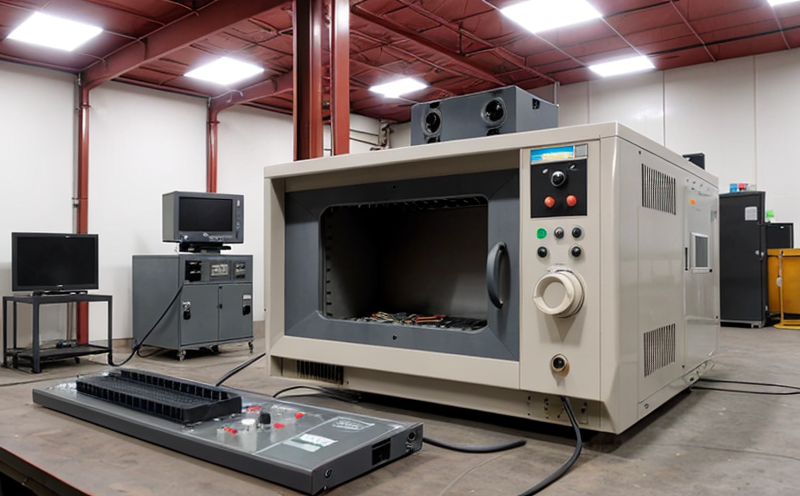GOST R 51317 EMC Testing for Industrial Electronics in Russia
The GOST R 51317 standard is a key regulatory requirement in Russia that ensures industrial and commercial electronics meet stringent electromagnetic compatibility (EMC) requirements. Compliance with this standard not only helps manufacturers navigate the Russian market but also enhances product reliability, robustness, and safety in challenging environments.
EMC testing under GOST R 51317 aims to ensure that electronic devices do not generate excessive electromagnetic interference (EMI), which could disrupt other equipment or cause malfunctions. Conversely, it ensures that the device itself remains functional when exposed to external electromagnetic emissions. This standard is particularly important for industrial electronics, as these products are often deployed in harsh environments where electromagnetic disturbances can be significant.
The testing process involves several stages, starting with a comprehensive assessment of the product’s design and specifications. This includes determining the appropriate test levels based on the device's intended use and environment. The following steps outline the key aspects of GOST R 51317 EMC testing:
- Preparation: Detailed documentation is required, including circuit diagrams, component lists, and power supply details.
- Field Testing: Devices are tested in controlled environments to simulate real-world conditions. This includes both conducted emissions tests (measuring the electrical signals that travel through conductors) and radiated emissions tests (testing for electromagnetic radiation).
- Compatibility Tests: The device is exposed to various types of interference, such as conducted and radiated fields, to ensure it can function correctly without causing interference.
- Radiated Emissions Testing: This involves placing the device in a special chamber designed to measure emissions over a wide frequency range. The test must meet strict limits for both conducted and radiated emissions.
- Conducted Emissions Testing: Similar to radiated emissions testing, but focuses on signals that travel through wires or cables.
- Acceptance Criteria: Devices must comply with the specified limits in GOST R 51317. Compliance is determined by comparing test results against these standards.
The use of GOST R 51317 ensures that industrial electronics are robust and reliable, which can lead to significant cost savings by reducing downtime and maintenance costs. Additionally, compliance with this standard enhances the reputation of manufacturers in the Russian market, potentially opening doors to new business opportunities.
| Test Type | Description | Key Considerations |
|---|---|---|
| Conducted Emissions | Measures electrical signals traveling through conductors | Ensure compliance with specified frequency bands and power limits. |
| Radiated Emissions | Tests for electromagnetic radiation from the device | Evaluate the impact on nearby electronic equipment. |
| Test Parameters | Acceptance Criteria |
|---|---|
| Frequency Range | From 150 kHz to 3 GHz, depending on the device type. |
| Field Strength | Measured in microvolts/meter (μV/m) or milliwatts/square meter (mW/m²). |
The process of GOST R 51317 EMC testing requires a combination of expertise, advanced instrumentation, and a deep understanding of the standards. Our laboratory offers comprehensive support to ensure that your industrial electronics meet these stringent requirements.
Customer Impact and Satisfaction
- Enhanced Product Reliability: Products that meet GOST R 51317 standards are less likely to fail in the field, reducing maintenance costs and downtime.
- Better Reputation: Compliance with this standard enhances your company's reputation as a leader in quality and reliability.
- Increased Market Access: Meeting these requirements can open doors to new business opportunities in Russia and potentially other markets.
- Improved Customer Satisfaction: Products that meet GOST R 51317 standards are less likely to cause interference with other devices, leading to a better overall user experience.
The impact of successful GOST R 51317 compliance extends beyond just the product itself. It also reflects positively on your company's commitment to quality and reliability, which is crucial for maintaining customer trust and loyalty.
Use Cases and Application Examples
GOST R 51317 EMC testing is critical for a wide range of industrial electronics. Here are some specific use cases:
- Factories and Manufacturing Plants: Ensuring that control systems, automation equipment, and communication devices do not interfere with each other.
- Power Plants: Protecting critical infrastructure from electromagnetic interference that could lead to safety hazards or operational failures.
- Mining Operations: Guaranteeing that mining equipment operates reliably in a highly challenging environment where electromagnetic disturbances are frequent.
- Hospitals and Medical Facilities: Ensuring medical devices function correctly without causing interference with other electronic systems, which is crucial for patient safety.
By ensuring your industrial electronics meet the stringent requirements of GOST R 51317, you can help prevent costly downtime, improve product reliability, and enhance customer satisfaction. Our laboratory offers comprehensive support to ensure that your devices are tested thoroughly and meet all specified requirements.
Competitive Advantage and Market Impact
In today's competitive global market, compliance with GOST R 51317 is not just a requirement; it can be a significant differentiator. By ensuring that your industrial electronics meet these stringent standards, you demonstrate a commitment to quality and reliability. This can enhance your company’s reputation, making your products more attractive to potential customers.
Moreover, meeting this standard can open doors to new business opportunities in Russia, one of the world's largest markets for industrial electronics. In addition, compliance with GOST R 51317 can also be a stepping stone to other international standards, further enhancing your product’s global appeal.
The competitive advantage gained from meeting these requirements is not just about regulatory compliance; it’s about building trust and confidence in your products. This can lead to long-term benefits, including increased market share and customer loyalty.





